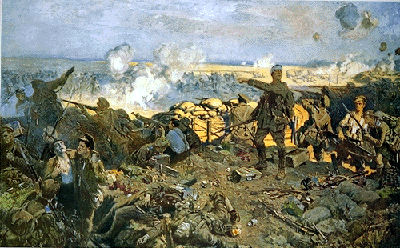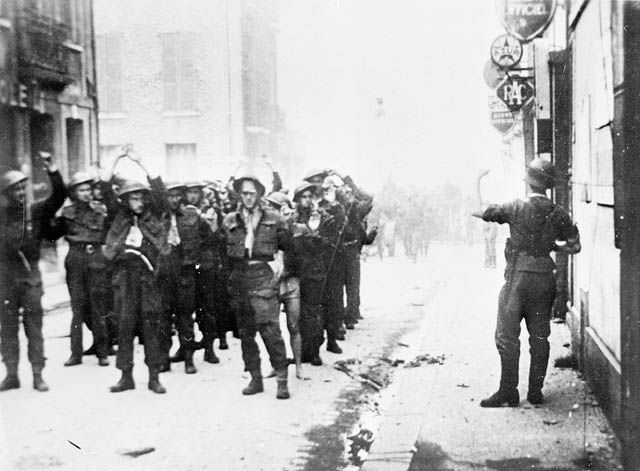
Early History
Prisoners of war are a by-product of relatively sophisticated warfare. In primitive fighting, prisoners were rarely taken. Instead, the vanquished were tortured (often ritualistically) or killed. In some cases, prisoners were permanently enslaved. Rich or powerful prisoners were sometimes held for ransom.
These options were practised by the Indigenous people of North America, and all — except ritualistic torture — were practised by the early European settlers in what would become Canada. By the end of the 18th century, however, most communities had changed their treatment of captured combatants. Most had accepted the principle of simply quarantining prisoners, either by confining them for the duration of the conflict, or gradually granting them freedom in some fashion (a practice known as parole). Such were the usual practices in the Anglo-French wars and the American Revolution during the 18th century, and the War of 1812 in the 19th century.
International Rules and Treaties
International rules to govern the treatment of POWs were first formulated at Geneva, Switzerland, in 1864 and were refined at The Hague in the Netherlands in 1899, as part of a broader codification of the rules of war. The new standards banned, among other things, the torture of POWs and the use of POWs as slave labour. They also included the right of POWs to adequate food, shelter and medical care.
Canadians taken prisoner during the South African War (1899–1902) had little need of these rules, however, since the Afrikaner enemy – fighting a guerrilla campaign for most of the war – had no facilities for holding prisoners. After being relieved of their weapons, equipment and supplies, Canadian prisoners were usually released. There were isolated incidents of the unlawful execution of prisoners, carried out by all sides in the South African War.
First World War
About 3,800 Canadians were taken prisoner during the First World War (1914-18), most of them soldiers captured in battle by German forces on the Western Front. One of the largest groups of Canadian POWs, about 1,400, was captured following the first major engagement of the Canadian Expeditionary Force, the Second Battle of Ypres in Belgium in April 1915.

In general, the greatest problems for Allied prisoners held captive in Germany were boredom, or worrying about the fate of friends and comrades who might have died or gone missing in battle, and the anxiety of not knowing when the war might end and how many years of captivity lay ahead. But life was not all tedium or fear. Some German prison camps allowed POWs to borrow books from camp libraries, learn skilled trades in camp schools, and publish POW newspapers.
Most POWs in Germany were treated in accordance with the revised Hague Convention of 1907. But there were also many complaints that the spirit of the convention was not observed and that prisoners were sometimes treated unfairly or inhumanely. By 1918, because of food shortages in Germany, POW diets suffered, along with those of the civilian population.
More than a decade after the war, in 1929, a Geneva Convention relating specifically to the treatment of POWs was negotiated through the League of Nations. Prisoners were to be treated humanely, subject to the need to secure them. A prisoner need only give his captors his name, rank and number; he might be required to work, but must not be assigned to work with direct military implications.
Second World War
In the Second World War (1939-45), nearly 9,000 Canadians became German POWs — usually soldiers captured during combat, airmen whose aircraft were shot down over enemy territory, or sailors picked up from the sea after their ships were torpedoed and sunk. Sometimes Canadians were taken captive in large batches — such as the 1,948 troops taken after the failed Dieppe Raid in August 1942. Others fell into enemy hands in ones or twos throughout the war — particularly the airmen shot down during bomber raids over Germany.

Most Canadians captured by Germany were treated in accordance with the Geneva Convention. As the war progressed, however, and general conditions deteriorated in Germany, so conditions also worsened for POWs, who faced increasing hunger as food became scarce.
There were also some blatant abuses of POWs and violations of the Geneva Convention. In one case, German secret police executed 50 Allied POWs, including six Canadians, who were among the 76 prisoners to take part in the famous "Great Escape" from the German camp Stalag Luft III in March 1944.
Perhaps the worst atrocity committed against Canadians during the war occurred after the D-Day invasion in June 1944, when as many as 156 Canadian soldiers were executed by their German captors in the Normandy countryside, after being taken prisoner (see Normandy Massacres).
Japanese treatment of POWs was among the most inhumane of the Second World War. In 1941, after the Battle of Hong Kong, 1,682 Canadians from the Winnipeg Grenadiers and the Royal Rifles of Canada (Québec City) were imprisoned at camps in Hong Kong and Japan. The POWs endured years of beatings, hard labour and inadequate diets. Hundreds of Canadians died from illness due to vitamin deficiency, or from slow starvation. In August 1945, the atomic bombing of Hiroshima and Nagasaki forced Japan’s surrender and ended the war in the Pacific – leading to the liberation of the Japanese camps. Many Canadians who survived the Japanese POW camps were traumatized by their experience and came home with deep bitterness toward Japan.

Korean War
Thirty-two Canadians became POWs during the Korean War (1950–53). They were treated harshly, often forced to do hard labour, or placed in solitary confinement for weeks or months at a time. Neither North Korea nor China had signed the revised Geneva Convention of 1949. Efforts were also made to "brainwash" the Canadian POWs in attempts to alter their political perceptions. For propaganda purposes, some were also pressured to sign fictional statements saying they had wrongly entered North Korean or Chinese territory, or that they disagreed with the war. None, however, died in captivity and all were freed after the war.
Canada's most famous Korean POW was Squadron Leader Andy MacKenzie. A Royal Canadian Air Force fighter pilot, MacKenzie flew combat missions in Korea with United States forces. In December 1952, he was flying his F-86 Sabre fighter near the North-South Korean border as part of an American fighter group when he was accidentally shot down by the "friendly fire" of one his fellow pilots. After parachuting into North Korea, MacKenzie was captured and spent the next two years in a Chinese prison, in difficult conditions that included occasional solitary confinement and mental torture. He was released in December 1954, a year and a half after the war had ended.
(See also: Internment in Canada and Prisoner of War Camps in Canada)

 Share on Facebook
Share on Facebook Share on X
Share on X Share by Email
Share by Email Share on Google Classroom
Share on Google Classroom
